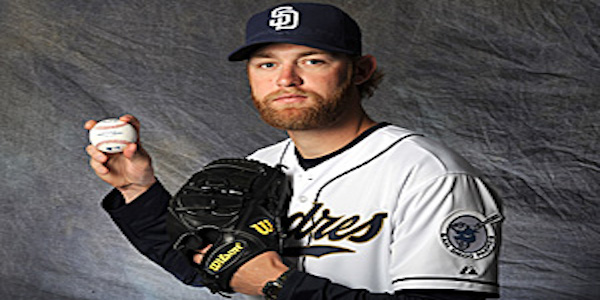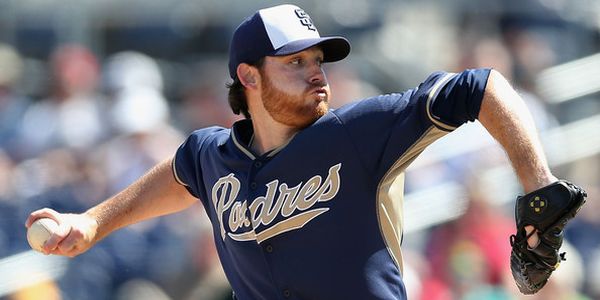2014 Fantasy Baseball: The Rubber, Week 7: Examining Fastball Usage


I was toying around with the pitch value Leaderboards on Fangraphs and got to looking at starters who have derived the most value from their fastballs so far this year. For the record, Fangraphs is grouping all variations of a fastball (i.e. four-seamer, two-seamer, sinker) into one category in this particular instance (with the exception of the cutter which is classified separately). For each pitcher, I multiplied each of their pitch values by their usage of that pitch to weight the contributions of each of their pitches. Of the 106 qualified starters so far this year, 18 had a fastball pitch value that was one standard deviation or more better than the mean.
Given that it’s generally accepted that good secondary stuff is almost always necessary for sustained success, I’m concerned that a few of those 18 pitchers don’t have another pitch with a positive pitch value. Here is a chart showing the pitchers I’m most concerned about.
Let me quickly dispense with Jarred Cosart. He’s owned in just 1% of ESPN.com leagues and has a 4.30/4.40 ERA/SIERA. I don’t need to talk anyone out of owning or adding him.
Ian Kennedy is a little more interesting. He’s the only one in the group who has another positive pitch value, but it’s his cutter. That’s essentially just another fastball. And he’s only throwing it about 3% of the time, so that’s not enough to alleviate my concern. But my concern is exaggerated by that comfortably negative curveball pitch value (wCB). Curveballs and changeups are typically how pitchers handle hitters of the opposite handedness. That was true for Kennedy when he had success in the past. Kennedy had a positive pitch value on his curveball in 2010 and 2011, which were the two years Kennedy had an ERA under 4.00 and an xFIP against LHH under 4.00 as well. In 2012 and 2013 his curveball pitch value was negative, and his ERA and xFIP against LHH were over 4.00. It seems like there’s a pretty strong relationship between Kennedy’s success and the quality of his curveball.
When you consider that Kennedy’s fastball has been just above average for his career, you would assume that he’d have to find his curveball again in order to maintain the success he’s had early in 2014. That assumption would be based on the expected regression of the value of his fastball. But Kennedy has seen a big spike in his fastball velocity. His fastball sat 89-90 prior to this year, but he’s averaging 91.7 mph with his fastball this year. Finally, something that alleviates my concern. I was big on Kennedy in the preseason, and I invested heavily in him in drafts, so I’m relieved to find some reason that this re-found success might be sustainable.
I’d still like to see some improvement from his curveball because he could be in trouble if he loses some or, god forbid, all of the velocity gains. But it seems unlikely that the curveball is coming back to the land of positive value given that the pitch hasn’t been above average since 2011. That makes Kennedy a somewhat risky proposition going forward, but if you don’t want to try and sell him, you have a reason to hold on to him with the velo spike. And even if you did want to try and sell high on him, I think you’d have a tough time. Because he was essentially a league average starter in 2012 and a well below average starter in 2013, his ADP was outside the top 200 on ESPN.com. My guess is that a lot of people still harbor some skepticism about him. If you can get a top 80 or so hitter or a top 30-35 pitcher with less risk for him, do it. But otherwise your best bet is probably to hope the velo holds and he returns a full season worth of big value on your small draft day investment.
Kennedy’s teammate, Andrew Cashner, is perhaps even more interesting that his fellow Padre. Cashner’s fastball has just been insanely awesome this year. The only qualified starter in 2013 whose fastball pitch value per 100 pitches was better than what Cashner has done this year was Matt Harvey. The only other pitcher who even came close to Harvey was Clayton Kershaw. So yeah, Cashner’s fastball has been truly elite so far. A quick look at his Fangraphs page will tell you that he’s shifted from a four-seamer to a two-seamer as Eno Sarris detailed recently. In that piece, Cashner stated the reason for the shift was to get more quick outs. Sarris notes that he’s succeeded in that endeavor in that he’s averaging under 15 pitches per inning this year compared to 17+ last year.
From a real baseball perspective and from the perspective of saving his arm in the long run, throwing more two-seamers is a good thing. But from a fantasy baseball perspective, it’s not exactly the best news. Eno has also recently done some great work detailing the league average whiff rates for specific pitches. As it turns out, sinkers (which is what Cashner calls his two-seamer) have the lowest whiff rate league-wide of any pitch. What’s worse is that Cashner’s whiff rate with the pitch this year (2.49%) is less than half of the league average rate. That’s why Cashner’s swinging strike rate is at an all-time low (6.9%) and why his strikeout rate is only league average.
He is getting whiffs at above average rates with his slider and chageup, but because he’s had so much success with his fastball, he’s only using his secondary offerings on about a quarter of his pitchers. In the interview with Eno, Cashner said he planned on mixing in his change a little more as the season goes along, but he’s relied so heavily on the fastball because of how well it has been working. As fantasy owners, we should hope he does start to mix in that changeup more ASAP.
Let’s assume for a second that he sticks with the fastball-heavy approach and his strikeout rate never rises. If he pitches 200 or so innings, then that would mean he would finish with somewhere around 165 strikeouts. Let’s also assume his ERA finishes in the low-to-mid threes where his ERA estimators currently sit, that his WHIP holds around 1.22, and that he wins 9-10 games as Steamer and ZiPS predict. How valuable is that? Well, John Lackey finished 2013 with numbers very similar to the ones I’m assuming Cashner ends up with, and he finished the year 43rd among starters on ESPN’s player rater. Without more strikeouts, it’s hard for me to argue that Cashner is more than a borderline top 40 fantasy starter. Which, by the way, is pretty much what he has been so far as he currently ranks 48th among SP on the player rater.
I could be wrong, but it’s my perception that other people perceive Cashner to be more valuable than that. Or maybe it’s that people think he has some nice upside. If my perception is right, my guess is that you could buy low on a top 30-ish starter by trading Cashner. I own Cashner in one league and I’ve got offers out to swap him straight up for Jordan Zimmermann and Cole Hamels, two guys I think are top 20 starters whose value may be depressed right now. If those trades aren’t accepted, I’ll move on and make offers to swap Cashner for Mike Minor, Doug Fister and Gerrit Cole. Maybe that’s shooting too high, but if I can’t get a guy like that for Cashner, I’ll just hold on to him and hope he mixes in more secondary stuff and his strikeout rate rises as the season moves along.




1 Comment
Would u trade utley for fister. I have cano as my 2b. 10tm h2h each cat